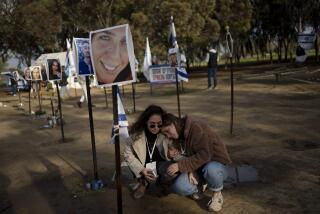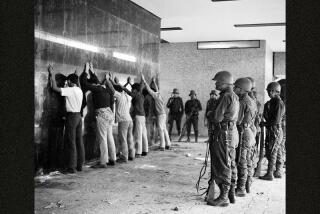50 Years After Historic Attack in Spain : Witnesses Recall Bombing Raid by Luftwaffe on Town of Guernica
- Share via
GUERNICA, Spain — A single peal of church bells was the first warning of the bombs.
“It was like the screeching of an owl,” Maria Aguirre recalled. “I picked up my boy Inaki in my arms and started to run. And then it seemed I would never stop running.”
Aguirre, now 78, stood at the doorstep of her farmhouse and pointed up the road toward Guernica: “It changed our lives, what happened then and what happened afterwards.”
At 4:40 in the afternoon of April 26, 1937, Nazi warplanes began the first systematic air raid in history on an undefended target.
Market Day
It was market day in Guernica, a center of Basque culture, and several thousand farmers jammed the streets alongside Guernica’s population of 6,000.
“We never learned how many died,” Aguirre, who ran a crockery shop then, said. “But so many of the faces I knew, I never saw again.”
The bombing was, as Adolph Hitler’s deputy Hermann Goering admitted, a trial run “for my young Luftwaffe.” It opened a new era in warfare that later claimed millions of victims in cities such as Coventry, Dresden, Hiroshima and Nagasaki.
“What did we have, six cannons? A few shotguns?” said Jose Larruzea Larrinaga, who took cover in a ditch with his two young nephews during the three-hour bombardment. “They came and went at their leisure. They flew so low you could see the pilots’ eyes.”
Aid to Fascists
To Hitler’s Condor Legion, sent to Spain to aid the Fascists in the 1936-39 Spanish Civil War, Guernica was a dot on the map 15 miles from the northern front.
Slowly and mechanically, heavy Junker 52s unloaded 100-pound bombs on the train station, a church, the marketplace. Then the swifter Heinkel 51s swooped over, strafing the fleeing villagers, machine-gunning donkeys and sheep, spilling incendiary bombs on rooftops and streets.
As Aguirre fled with her 17-month-old son, one of the Heinkels pursued her along a river bank.
“It chased me around and around a pine tree,” she said. “It lasted 10 minutes, I think. It is silly, but I screamed, ‘Why me? Why me?’ ”
Reduced to Rubble
In three hours, Guernica was reduced to rubble. Two days later Franco’s troops took the town unopposed.
The destruction of Guernica, where for centuries Spanish kings had sworn to observe Basque rights, broke the back of Basque resistance and paved the way for Franco’s fierce repression of the region’s ancient culture and language.
The bombing also focused world attention on the cruelties of the Spanish Civil War, which began July 18, 1936, when Franco led rebel forces in an uprising against the democratically elected Republican government. Half a million Spaniards died in the war, which ended in Franco’s victory in 1939.
War correspondents in Spain, including Ernest Hemingway, warned that Hitler was using Spain as a training ground for a wider European conflict.
‘Red Hordes’ Blamed
Franco responded to the uproar abroad by declaring that “red hordes” had burned and dynamited the town as they retreated from Fascist troops. Only after his death in November, 1975, did Basques recover the right to speak freely on such topics as what really happened on April 26, 1937.
“Over the years it was the silence and the lies that pained us most of all,” Roman Catholic Father Jose Luis Abaunza, 79, said. “How were we Basques going to destroy the symbol of Basque liberty?”
He opened the yellowed pages of a parish ledger in the sacristy of the church of Santa Maria.
“Look, it says here, so-and-so died of wounds suffered in the bombing-- el bombardeo ,” Abaunza said.
The ‘Catastrophe’
“Under Franco we had to call it the ‘catastrophe,’ for example, because they would jail you if you spoke of bombs,” he added angrily.
Scores of German bombs were unearthed as the town was rebuilt. But Spanish news media were not allowed to report the finds.
No final casualty list was ever compiled. Francoist historian Ricardo de la Cierva maintains that the victims numbered “less than a dozen.” But most historians believe that at least 1,200 died.
American historian Herbert Southworth, author of the most detailed account of the bombing, estimates 1,600 dead and 900 wounded. British correspondent G. L. Steer, who witnessed the pathetic efforts to save the burning town, later wrote: “But nothing could be done, and we put our hands in our pockets and wondered why on Earth the world was so mad and warfare become so easy.”
Never Forgave Basques
Franco, who called his uprising a “crusade” to save Spain from atheism, never forgave the Basques, traditionally the country’s most pious Catholics, for siding with the republic. He even outlawed the Basque language.
“I had to change my son’s name to Ignacio because they said Inaki was a beast’s name,” Aguirre said. “If the police heard you speaking Basque, they would stop you and tell you to speak Christian.”
Local officials were unable to convince the government in Madrid to ship Picasso’s masterpiece “Guernica” to the town to commemorate the anniversary.
Most people in Guernica, which now has a population of 17,000, believe that the painting should hang there permanently.
‘It Is Our Painting’
“It is our painting,” town hall translator Victor Zarrabeitia said. “In Madrid it is out of context. It is as if you had a pyramid displayed outside Egypt.”
Madrid officials argued that Guernica could not ensure the protection of the 11-by-25-foot canvas, which now hangs in a bulletproof glass cage at a Prado museum annex where entering visitors must pass through a metal detector.
Picasso refused to allow the painting to be displayed in Spain until democracy was restored. It hung in the Museum of Modern Art in New York City from 1939 until 1981, six years after Franco’s death.
The painting starkly portrays the horrors of the bombardment in black, gray and white. It has come to symbolize the atrocities of all wars.
More to Read
Sign up for Essential California
The most important California stories and recommendations in your inbox every morning.
You may occasionally receive promotional content from the Los Angeles Times.










